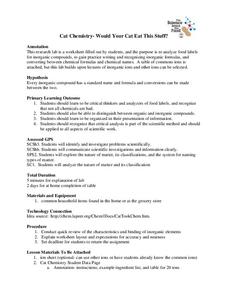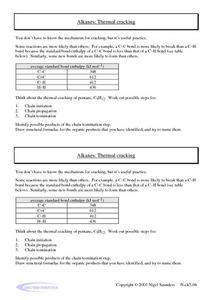Royal Society of Chemistry
Chemistry Masterclass—Chemistry Outreach
Immerse your chemistry class in the world of organic chemistry! Science scholars isolate acetaminophen from an over-the-counter sample during an intense and interesting lab. Groups use many different separation and analysis techniques to...
Royal Society of Chemistry
Organic Molecules Day—Chemistry Outreach
In search of an organic lab that employs real-life techniques and analysis methods? Groups carry out the nitration of methyl benzoate, then attempt to determine the number and location of the nitro groups added to the benzene ring....
Royal Society of Chemistry
Electrochromic Polymer—Chemistry Outreach
From windows that tint themselves to OLED technology, electrochromic polymers are redefining our ideas about conducting materials! Introduce your chemistry class to the emerging trend with an exciting lab activity. Budding materials...
Creative Chemistry
Aliphatic Reaction Pathways
Complete a graphic organizer of aliphatic reaction pathways. Chemistry aces fill in the chemical formulas of the different hydrocarbon compounds as they inspect products of different reactions. Using a graphic organizer allows learners...
National Nanotechnology Infrastructure Network
Synthesis and Characterization of CdSe Quantum Dots
Does the size of a sample change the physical properties of that substance? It turns out it can! Young scientists combine physics and chemistry to synthesize CdSe quantum dots and record their color properties. Learners should...
Royal Society of Chemistry
Lead Compounds: Precipitation Reactions and Pigments—Microscale Chemistry
Colorful lead compounds never fail to impress! Solubility scholars examine a series of double replacement reactions involving lead nitrate and record their observations. The second part of the experiment illustrates the differences...
Curated OER
Summary of Shapes of Molecules
Neatly organized and easy to read, this chart summarizes five different molecular shapes: linear, trigonal planar, tetrahedral, trigonal bipyramidal, and octahedral. It associates shapes with electron pairs and atom arrangement and lists...
Royal Society of Chemistry
A Giant Silver Mirror Experiment
Mirror, mirror, on the wall ... who's the best chemistry teacher of them all? You'll get the vote for certain after your class completes the Silver Mirror experiment! Partnered pupils use Tollen's reagent and glucose to silverplate a...
Maryland Department of Natural Resources
Eyes on Dissolved Oxygen
Learn about the factors that affect the way oxygen dissolves in salt water with a chemistry lab. After studying the molecular structure of water, young scientists figure out how aeration, temperature, and organic waste affect...
Creative Chemistry
Formulae of Ionic Compounds - Practice
In this compound worksheet, students complete a graphic organizer by combining positive and negative ions appropriately and writing down the resulting compound.
University of Georgia
Would Your Cat Eat This Stuff?
Processed foods use inorganic compounds for flavoring and preservation. This take-home laboratory challenges scholars to find 20 different compounds identified on the labels of foods to list on their data collection sheet. The activity...
Creative Chemistry
Physical and Chemical Trends in the Group 7 Elements
In this elements worksheet, students complete a graphic organizer by comparing the elements' melting point, boiling point, density, and electronic configuration. Students determine the characteristics of Group 7 elements. This worksheet...
Creative Chemistry
Physical Properties of Group 1 Elements
In this elements worksheet, learners complete a graphic organizer by filling in the symbol and atomic number for the given elements. Students plot a graph of melting point against atomic number. Learners write the electron arrangements...
Creative Chemistry
Trends in Physical Properties of Group 2 Elements
In this elements learning exercise, learners complete two graphic organizers by comparing the element symbol and melting point for given elements. Then students plot a graph of their atomic radius against proton number.
Creative Chemistry
Salts
In this salts worksheet, students read how salts are created and how different acids make different salts. This worksheet has one graphic organizer and seven short answer questions.
Creative Chemistry
Reactions of Group 1 Metals With Water
In this elements learning exercise, students complete a graphic organizer comparing lithium, sodium, and potassium observations. Then, they determine how these elements react with water. Students complete three fill-in-the-blank questions.
Creative Chemistry
Calculating the Number of Sub-Atomic Particles in an Atom
For this atoms instructional activity, high schoolers compare sub-atomic particles' position, relative charge, and relative mass. High schoolers define mass numbers and atomic numbers. This instructional activity has two graphic...
Creative Chemistry
Electron Arrangement
Students complete a graphic organizer for this ion's activity by filling in the successive ionization energies for potassium. Then, they create a graph plotting ionization energy against the number of ions.
Creative Chemistry
Alkanes: Physical Properties
For this alkanes worksheet, students complete a graphic organizer by filling in the number of carbon atoms for the given alkanes. Kids plot a graph showing how physical properties change with the number of carbon atoms. Then, students...
Creative Chemistry
Electron Arrangement First Ionisation Energies in Group II and Period 3
Students complete two graphic organizers in this ionization instructional activity by filling in the proton number for given elements. Then, they create two graphs plotting the first ionization energy against the proton number.
Creative Chemistry
Electron Arrangement Ionization Energies in Group I and Period 2
In this electron arrangement activity, students complete two graphic organizers by determining the proton number of given elements from their first ionization energy. Then, they plot graphs of the first ionization energy against the...
Pingry School
The Gelation of Guar Gum with Borax
Some of kids' favorite toys are the products of science experiments. Scholars follow precise measurements to mix and create their own slime and Play-Doh. They observe the changing textures and the chemical reactions throughout the...
Creative Chemistry
Alkanes: Thermal Cracking
For this alkanes worksheet, students compare the average standard bond enthalpy for common bonds. Then, students complete three short answer questions.
National Nanotechnology Infrastructure Network
The Effects of Gold and Silver Nanoparticles on Brine Shrimp: A Toxicology Study
Who doesn't love gold and silver? Brine shrimp, that's who! Learners conduct an experimental lesson to monitor the toxicity of gold and silver nanoparticles on brine shrimp. They synthesize solutions to expose the brine shrimp to and...
Other popular searches
- Organic Chemistry Projects
- Organic Chemistry Activities
- Naming Organic Chemistry
- Organic Chemistry Alcohols
- Organic Chemistry Lab
- Organic Chemistry Model Sets
- Organic Chemistry Quizzes
- Organic Chemistry Detergent
- Simple Organic Chemistry
- Organic Chemistry Reactions
- What Is Organic Chemistry
- Organic Chemistry I























